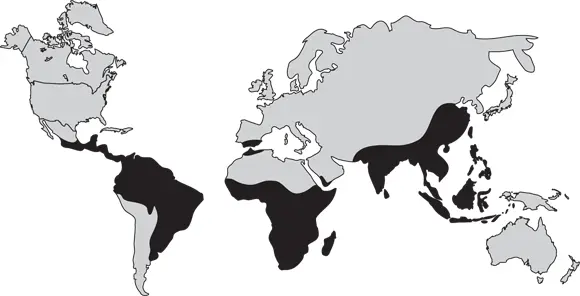Although many primates occasionally stand up to walk on two feet (and one gorilla in West Africa has even been observed to use a walking stick to cross a swampy patch of ground), they do so on occasion rather than habitually. Of the living primates, only Homo sapiens sapiens walks on two legs; I discuss why that’s a fascinating question in Chapter 6. For the moment, take a look at the main anatomical characteristics of bipedal primates:
Relatively long, strong legs
An S -shaped spinal column that acts as a spring to absorb stresses
A wide pelvis that keeps the thighs somewhat apart, helping balance
A parallel big toe lined up with the rest of the toes (rather than the divergent big toe used by other primates to grasp tree limbs)
Thighs that angle inward toward the knees and down from the pelvis, also assisting balance
Lateral and transverse arches built into the foot so that we aren’t flat-footed but supported by three main points of contact (the heel and under the big and small toes) in a stable, tripod-like structure
 Humans aren’t the only species ever to evolve bipedalism; kangaroos are another, and, given enough time and the right circumstances, bipedalism could easily evolve again, perhaps in the African meerkats, who spend a lot of time standing on their hind legs. But among the primates, humans are the only living habitual bipeds. As Chapter 6shows, though, other primates did evolve bipedalism and used to be quite numerous between about six million and two million years ago.
Humans aren’t the only species ever to evolve bipedalism; kangaroos are another, and, given enough time and the right circumstances, bipedalism could easily evolve again, perhaps in the African meerkats, who spend a lot of time standing on their hind legs. But among the primates, humans are the only living habitual bipeds. As Chapter 6shows, though, other primates did evolve bipedalism and used to be quite numerous between about six million and two million years ago.
Monkey See, Monkey Do: Primate Social Groups and Behavior
Primates are very social creatures, and although other social mammals (like zebras) live in groups, primate social groups are extremely complex, with elaborate rank hierarchies and codes of conduct. Anthropologist Franz de Waal even called one book about chimpanzee behavior Chimpanzee Politics. Primate groups are also usually (but not always) quite large; baboon troops can have up to 300 members.
 Keep in mind that social behavior can depend on group size, which can in turn depend on variables such as whether the species is nocturnal or diurnal, what kind of foods it focuses on, what its local environment is like, and so on. The complex interplay between these variables is, I think, just being understood by anthropologists, who have spent much of the last few decades simply observing, understanding, and then describing (rather than comprehensively explaining) the variety of primate social behaviors.
Keep in mind that social behavior can depend on group size, which can in turn depend on variables such as whether the species is nocturnal or diurnal, what kind of foods it focuses on, what its local environment is like, and so on. The complex interplay between these variables is, I think, just being understood by anthropologists, who have spent much of the last few decades simply observing, understanding, and then describing (rather than comprehensively explaining) the variety of primate social behaviors.
Primates live in large, complex groups for three main reasons:
Protection from predators (protection in numbers): Predators can be put off by large, noisy, and dangerous groups of primates (like troops of baboons), and in a large group, one individual member is less likely to become lunch for a big snake or eagle.
Greater access to food: Larger groups who inhabit areas where food is distributed unevenly in the forest are more likely to find food patches because they have more eyes looking.
Raising offspring: Primates reproduce not by having vast numbers of offspring (like fish or frogs) but by having relatively few offspring that require a lot of care, both to protect them from predators and to teach the babies to socialize.
The following list describes the four main kinds of primate social groups:
Loners: This kind of social organization is called noyau . Only the nocturnal primates (like some of the prosimians discussed earlier in the chapter) and the orangutan have evolved noyau, in which males wander alone, staying with mates only long enough to mate. Females are also solitary, unless they have young, which they carry as they move around.
Families: Humans love families (or the idea of families) so much that we’ve been watching the Simpsons — Marge, Homer, Bart, Lisa, and Maggie — for 20 years (and they’re only one of a gazillion fictional families shown on television for the past 50 years); we’ve probably been telling stories about human families as far back as anyone can remember. In the primate order, monogamous families of a mated male and female with their offspring pop up among some gibbons and other kinds, but monogamy is actually quite rare in the primate order outside the human species.
Troops: Troops are multi-male, multi-female groups that contain no stable, long-term male-female mating relationships; males and females each have several mates. This situation is most common among the semi-terrestrial primates, whose groups may number into the low hundreds. These troops’ large numbers protect them from the big, terrestrial predators like leopards and lions and can help in finding food by sending scouts out on reconnaissance treks.
Harems: Groups that contain a single male, several females, and their offspring are known as polygynous groups or harems . Gorillas live this way; silverbacks, the dominant males, typically kick out male youngsters that are starting to come up in the ranks. They sometimes tolerate powerful young males for a while, but in the end the young guys normally have to leave. When they do, they have to find another group, defeat its silverback, and live to be the dominant male. It’s not an easy life.
Just when you have a handle on primate characteristics and behavior, another unusual situation arises. In this case, it’s polyandry , the social pattern among nonhuman primates in which a single female has several male mates. This tendency is only found among the tiny, nocturnal, insect-eating marmosets and tamarins.
 IS THAT A THREAT?
IS THAT A THREAT?
Primate social behavior isn’t always sweetness and light. Like many animals, primates often threaten one another, but coming to actual physical blows is rare; it’s just too risky. A better tactic is to bluff, and plenty of that goes on: Chimpanzees scream, throw sticks, slap the ground, and bare their teeth, all in an effort to intimidate — and it works. Over the eons, intense competition among primates has favored those with large, intimidating canines; the baboons’ teeth can be knife-like and particularly scary. Among humans, most threats and displays of prowess are accomplished verbally or with objects that show our rank, and so the pressure for especially big canines has lifted. This pattern seems to go back at least 2 million years, where fossil evidence indicates that our early ancestors’ canines aren’t as large as they are in most primate species.
Primates Today (But For How Long?)
The living primates — anywhere between 233 and 290 species, depending on whom you talk to — are widely distributed from South America to Africa to Japan. (Figure 4-6 shows this distribution.) Most are found in the tropics or semi-tropics (within 1,500 miles north or south of the equator). New species still occasionally surface — for example, the sideburn-sporting titi monkeys of South America (found in 2002) and two new lemur species found in 2005 in Madagascar. Some species are flourishing in large wilderness areas, but development is steadily reducing and fragmenting these regions.

Illustration courtesy of Cameron M. Smith, PhD
Читать дальше

 Humans aren’t the only species ever to evolve bipedalism; kangaroos are another, and, given enough time and the right circumstances, bipedalism could easily evolve again, perhaps in the African meerkats, who spend a lot of time standing on their hind legs. But among the primates, humans are the only living habitual bipeds. As Chapter 6shows, though, other primates did evolve bipedalism and used to be quite numerous between about six million and two million years ago.
Humans aren’t the only species ever to evolve bipedalism; kangaroos are another, and, given enough time and the right circumstances, bipedalism could easily evolve again, perhaps in the African meerkats, who spend a lot of time standing on their hind legs. But among the primates, humans are the only living habitual bipeds. As Chapter 6shows, though, other primates did evolve bipedalism and used to be quite numerous between about six million and two million years ago. IS THAT A THREAT?
IS THAT A THREAT?











